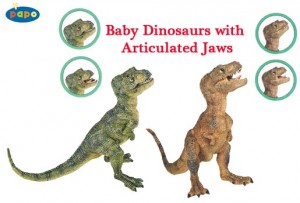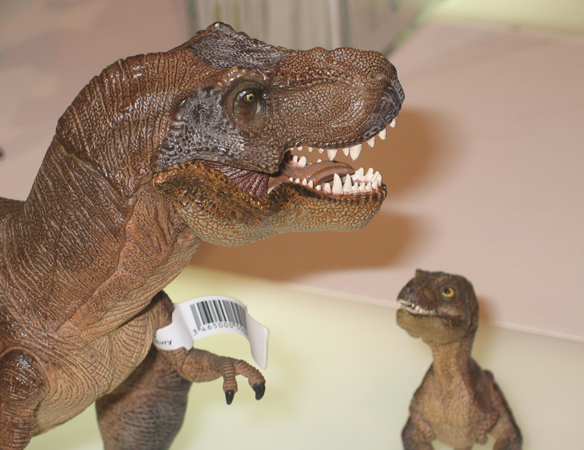Papo Baby T. rex Dinosaur Models Reviewed
Hot on the heels of the two 2012 product releases from Papo depicting adult tyrannosaurs (the running T. rex model and the new standing T. rex in brown with a re-sculpted head), comes the addition of two models of baby tyrannosaurs. There is certainly a T. rex bias in the current Papo “Les Dinosaures” model range, out of the twenty-five models currently available, five of them represent Tyrannosaurus rex. The proportion of tyrannosaurs to other replicas is certainly high, it will be reduced slightly with the introduction of the new Brachiosaurus replica (due to be with us in July, 2012), but for the time being, twenty percent of Papo’s “Les Dinosaures” output is dedicated to the “King of the Tyrant Lizards”.
Baby T. rex Dinosaur Models
This review focuses on the baby T. rex dinosaur models, the manufacturer’s objective; to permit dinosaur model fans to create scenes where an adult Tyrannosaurus rex can be featured with a youngster.
The fossil evidence for young Tyrannosaurus, can be described at best as being patchy. Unfortunately, there are very few fossilised remains of baby dinosaurs, that is dinosaurs that have hatched and left the nest, preserved in the fossil record. Their small bones are less likely to be preserved and it is probable that any small creature that died would soon have its carcase scavenged and eaten.
A controversial specimen, tentatively described as a baby Tyrannosaurus rex has helped scientists at the Los Angeles County Natural History Museum exhibit three skeletons of T. rex, an adult, a teenager and a juvenile all feeding off the body of a dead Edmontosaurus. This exhibit, part of a multi-million dollar refurbishment of the dinosaur halls at this Californian museum, depicts tyrannosaurs showing their different growth stages. This is the first time, that tyrannosaurs have been depicted in a family group. Luis Chiappe, the Director of the Museum’s Dinosaur Halls would be intrigued to see how Papo have interpreted the young T. rexes.
Tyrannosaur Growth Series
The growth series is a fascinating look at the ways that T. rex specimens grew, a process that included incredible growth spurts and body changes. After hatching as a 2-foot, 6-pound baby, for example, a T. rex could reach 30 to 35 feet (10,000 to 12,000 pounds) in less than two decades – if it was lucky.
The baby in the Los Angeles exhibit measures approximately eleven feet long. Palaeontologists have estimated that the fossils that have been used to create this part of the tyrannosaur diorama come from a two-year-old animal. The Papo dinosaur models represent much younger dinosaurs, perhaps less than a year old.
To view the Papo Dinosaurs model range: Papo Dinosaur Models and Prehistoric Animal Figures.
The two Papo models are from the same mould. They are identical apart from their different colourations. There is one T. rex baby which has been coloured using the green hue which was used in the original Papo standing T. rex sculpt and in the new running tyrannosaur model. The second model has been painted brown, presumably to co-ordinate with the new version of the standing T. rex dinosaur model that was introduced this year (also painted brown).
Both models are posed with the neck craned up and the head slightly to one side, as if the youngster is looking up at its parent, perhaps begging for food. Scientists have very little fossil evidence to study which indicates the nesting behaviour of tyrannosaurids. Palaeontologists have proposed that the Dinosauria exhibited both altricial and precocial patterns of growth and development.
Animals which are altricial are helpless when first born, unable to feed themselves, without down or body hair to help camouflage them or to keep them warm. The young remain within a nest environment for some time relying on their parents to look after them. Examples of altricial animals today include marsupial mammals, woodpeckers, most garden birds and of course, our own species. Evidence from “Egg Mountain” in Montana suggests that the duck-billed dinosaur, Maiasaura (M. peeblesorum) may have exhibited altricial behaviour.
Baby T. rex Dinosaurs from Papo
Picture credit: Everything Dinosaur
Precocial animals tend to be much more independent, mobile and capable than their altricial counterparts. They can move, defend themselves and hunt. Examples of precocial animals today are reindeer and gnu which within minutes of being born are able to run and keep up with the rest of the grazing herd. Crocodilians exhibit precocial behaviour. With American alligators for example, young animals may benefit from the protection of their mother which is nearby, but the young gators are able to hunt for themselves. Scientists have speculated that some types of dinosaur may have exhibited precocial behaviour with other types of dinosaur exhibiting nurturing and offspring/parental behaviours between these two extremes.
It is not known how tyrannosaurs nested, although there is some evidence to suggest that some tyrannosaurs may have lived and hunted in small family packs. If this is the case then the Papo models might depict a young animal that has left the nest and is now accompanying the adult animals as they travel throughout their territory, with the intention of hunting.
One of the concerns raised when these models were first being developed, was how to protect what would be tiny forelimbs. In order to prevent the arms from being broken, either in transport or through careless handling, the arms in both models are held close in to the chest (in fact attached to the chest as a single cast). The resulting pose of the two models does not look unnatural.
A Pair of Papo Tyrannosaurus rex Models
Picture credit: Everything Dinosaur
The skull is relatively big and the eyes are large, traits seen in young animals. The snout of the young T. rex models is rather short and blunt, allowing for a lengthening of the snout as the animal grew and matured (ontogenic changes as an animal grows into an adult). Both models have articulated lower jaws, the the dinosaurs can be posed either mouth open, mouth closed or part way between the two. The interface between the head and the underside of the neck on both replicas does not permit the jaws to be opened very far. Baby tyrannosaurs, would have been able to open their jaws much wider.
As no indication of ages is provided by Papo, and due to the lack of fossil evidence no scale can be given for these two dinosaur models, the best guess would be that these replicas represent animals under twelve months old.
Each model measures twelve centimetres long, with a head height of approximately nine centimetres. As with all the Papo models they are well painted and show lots of nice detail. The base of the tail is resting on the ground, this helps support the model as the feet surprisingly; are quite small. With young animals, the legs and feet are usually out of proportion with the rest of the body (concept called distal growth), this would have had a tendency to make baby tyrannosaurs look a little leggy and clumsy, but Papo have avoided this by using the tail to assist the model’s balance thus enabling the feet to remain relatively small.
Interesting to note the addition of these two replicas to the Papo “Les Dinosaures” range, which we are sure will please collectors and dinosaur enthusiasts alike. After all, you really can’t go wrong with a Papo Tyrannosaurus rex!





Isn’t it now accepted that dinosaurs held their tails in the air due to a lack of fossilized drag marks from their tails?
Most dinosaurs did hold tails off the ground but tail drag impressions are found in the fossil record we have seen them ourselves. Dinosaurs may have rested on the tails, but tripodal stance favoured by model designers as it helps with the stability of the recplica.